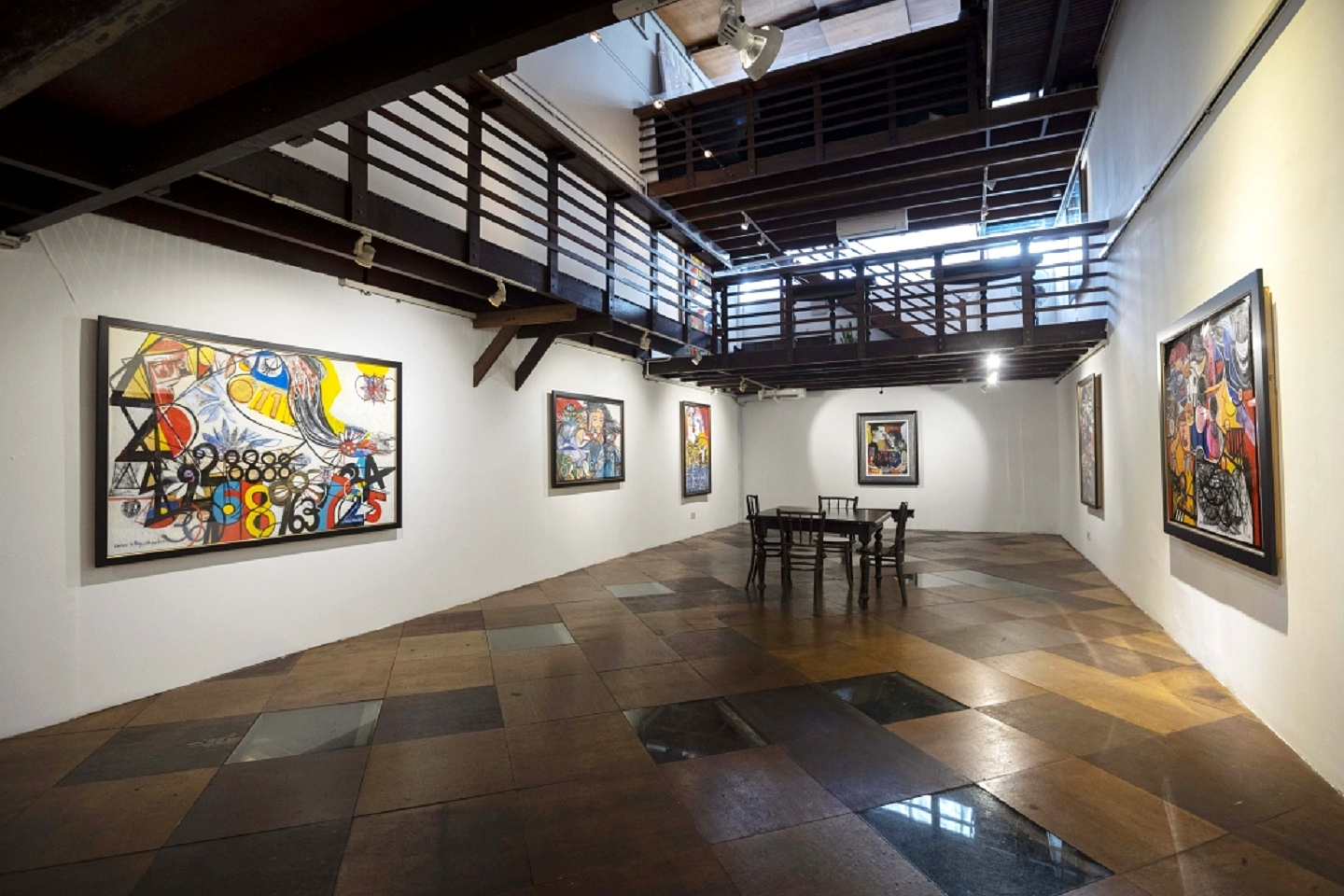
While figuration remains central to many of the works, it is the abstraction and energy and freedom in which it is expressed that captivates (All photos: Wei-Ling Gallery)
It was quite a surprise to hear of a new exhibition by Puan Sri Norma Abbas, considering that she, one of Malaysia’s most established senior visual artists, is equally known for keeping a low profile.
Her last show was a mini-retrospective by the Bank Negara Malaysia Museum and Art Gallery in 2016 — A Colourful Journey to a Promise — which encapsulated the personal nature of her artistic career and body of work.
The Covid-19 pandemic, family loss and health struggles saw Norma take time out to recover and regroup. The artist tentatively started painting again last year, though only seriously picking up her pace and completing a few new works this year, just in time for her Coded Diaries exhibition, now on at Wei-Ling Gallery in Brickfields, Kuala Lumpur.
“Every five years, people’s life and personality change,” says Norma of her motivation to push forward with the showcase. “I wanted to see where I have progressed in my art.”
Featuring 11 paintings both old and new, there is a distinctive tonality that brings this series together. While figuration remains central to many of the works, it is the abstraction and energy and freedom in which it is expressed that captivates.
Central to this is numbers, a recurring element that runs through many of the newer works. It was something she first explored in 2017, when she was commissioned to do some paintings on numbers related to her 99 Names of Allah series.
relaxing-with-kiddos-1030x686.jpg
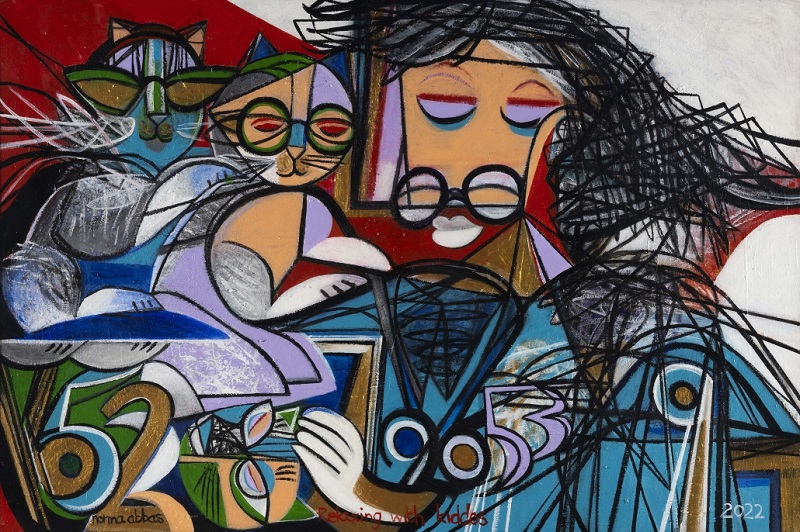
They soon fascinated her. “It was something new that broke me out of my comfort zone, and was so difficult at first,” says Norma. “I didn’t want to do just random numbers, so I did some research,” she says. It led to an obsession with scientist Nikola Tesla’s 369 theory. The three digits appear prominently in her initial number paintings.
She took time to develop a style of her own, spending more than two years intermittently on a small painting to start with.
These numbers are woven into the vibrant pieces like an enigma. Along with their unique motifs, figures and colours, each painting presents a story in code. Take Cat Lady (2022), for example. The artist describes a spiritual lady holding beads in her hands, with the red aura in the background and a white light at the fore. She is also a protector of animals, with some cats awash in blue and gold.
“My work has always been coded diaries, since I was young,” Norma says, though she believes the message of each canvas speaks loudly enough.
In both the artist and her art, there seems to be a sense of duality at play. For a self-confessed recluse, Norma is refreshingly candid and frank. Our conversation is somewhat like staring at her artworks; there are the obvious themes and topics — ranging from spirituality, relationships and family to her beloved cats — and, if one wished to further decode, the emotion, philosophy and personal revelation behind these seemingly everyday vignettes.
In Woman in Baju with numbers (2019), the floral motifs and random numbers belie some personally significant meaning. “Spiritually, 8888 has meaning, so does 111. I was going through a difficult time then — life is not easy,” says Norma matter-of-factly.
nz7_2900-1030x687.jpg
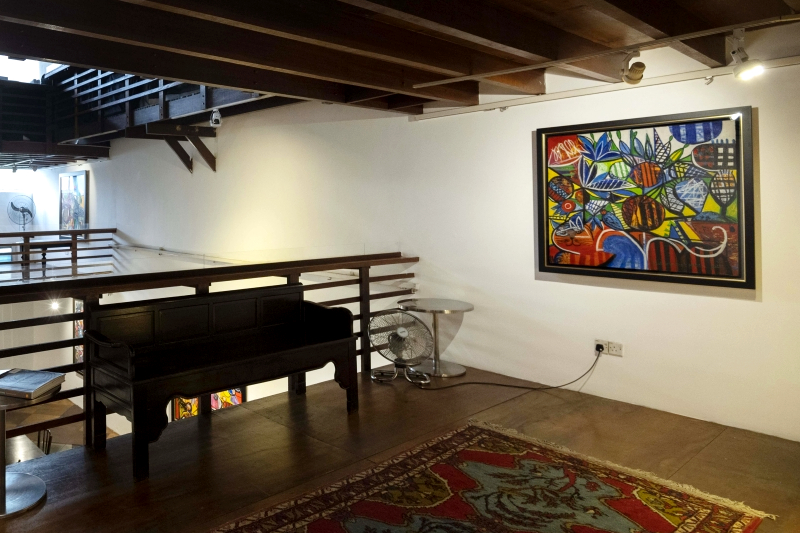
Titat Girl in Stripe Pants (2022) stars Titat Girl, one of her cats she encountered rather extraordinarily, in a rather joyous or light-hearted scene, while I Made a New Friend (2019) features a new friend she met during the Raya festivities. “She really inspired me. My friends have said if I see them often enough, they will appear on my canvas,” laughs Norma.
As someone who enjoys close, enriching friendships with women, she reasons that is why many of them appear in her artworks, interpreted her own way. Of the two men featured in her works, one is in a much earlier work, The Proposal (1999/2000). The biographical painting depicts a version of herself side-by-side with that of her late husband, Tan Sri Zain Azraai Zainal Abidin.
“Tan Sri looks handsome here but, at the time, he was ill,” she recounts. “He thought he had more time. The doctor said if he took care of himself, he could have a few more years, and so he decided to propose then — he had cancer and just had a major operation. But even if for one day or a few hours, I would have still married him.”
She says he might have lived longer if he had stayed in the UK for treatment, where facilities were better for cancer patients. He died in 1996, one year before her own father passed on. “That is what life is all about. Life is about challenges; I think it’s all about dugaan — more than happiness, sadness, death … God wants to see how you survive, to make you stronger,” Norma says emphatically.
But lest one thinks making art is an act of catharsis and/or exorcism of life’s struggles for her, Norma firmly shuts down the notion. “No, I feel none of that. I just feel I am sharing a story with someone who may be undergoing something similar, for like-minded people who may be going through what I have. Everyone goes through something in his or her life.”
nz7_2884-1030x687.jpg
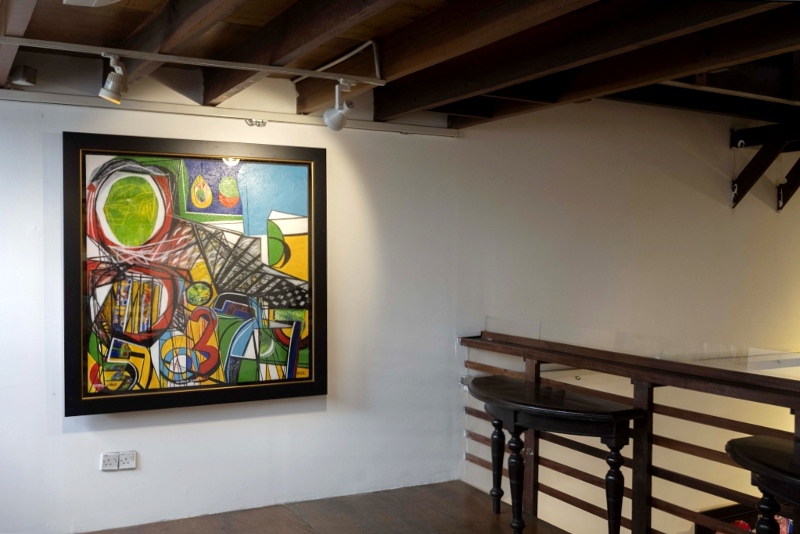
Her aversion to the romanticising of her experiences stems, perhaps, from an ingrained sense of self-effacement, but with it also comes a dislike of absolute statements about life or herself.
“I don’t like it because life has fate and destiny. Fate you cannot fight, but destiny is in your hands,” says Norma. Yet, she says there is also God’s hand. “You can plan, do this or that. But it may not work out, anyway. So, you must be flexible to understand that it may not be what the Almighty has for you.”
If there was one absolute path made clear to her from a young age, it was that of art. She recalls the only time her father smacked her was when she was six or seven. “I was drawing on the ground, and the call for Maghrib came. My father, who was a colonel then and very strict, said, ‘Norma, Maghrib, masuk rumah.’ I refused because I was still drawing.”
Her passion for art became even more evident during her school days. Though she initially wanted to study design, a figure painting class in college made her fall in love with this genre. She chose textile design and printmaking as her main disciplines, however, as she did not want to go down the traditional academic route and become a teacher.
Urged by her own teachers — such as Jolly Koh, the late Redza Piyadasa and Joseph Tan — who saw her promising talent, Norma took an art loan and headed to the UK after her second year at UiTM (Universiti Teknologi MARA) in 1975, first pursuing a bachelor of arts in Manchester Polytechnic School of Art, then a masters in autographics print making at Chelsea School of Art, London, in 1982.
norma_abbas.jpg
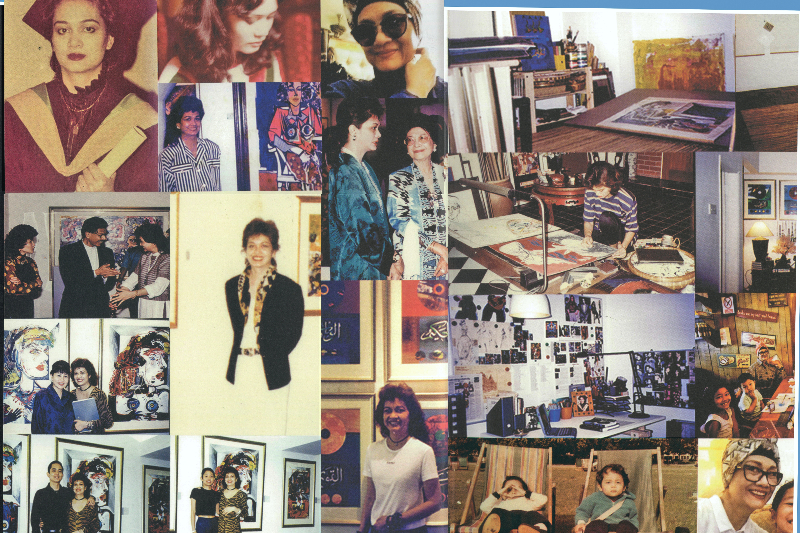
From a lack of finances to culture shock, societal norms — interestingly, Norma says if she had a choice, she would not have chosen to get married — and just a low regard for professional artists in Malaysia, she says, “I had to fight to become an artist.
Wisely enough, she knew that being a professional artist at a young age was not ideal. “I wanted to learn what the world was about, to know about other aspects, like marketing. You cannot be, as they say, ‘gong-gong’, or ignorant,” she points out. An in-house art department job with a Petaling Jaya-based cigarette factory became her first proper job.
“My God, I didn’t know what I was doing, but I learnt. I was given experiences, sent to seminars. I was made the head of department, where we did graphic design and packaging design. In 1988, when the economy wasn’t doing well, we were all retrenched and the factory closed down. But the whole experience opened my mind as a person. I find that being an artist, if you’re not exposed to life or anything else, you become enclosed in your thinking, small-minded.”
Having saved her salary over the three years to buy art materials, Norma was primed to start her professional art practice. She got her foot in when she submitted two works to the National Art Gallery for its annual show for new artists and, through her first husband, started selling her paintings at his brother’s art gallery in the old Subang airport. Most of the collectors of these early works were foreigners passing through.
In 1989, Norma approached the established Galeri Citra and was offered a two-person showcase with Khalil Ibrahim, Liku-Liku Hidup, marking the start of a 20-year collaboration with the gallery, including her first solo exhibition in 1995 and 99 Names of Allah Part 1 in 1999.
With contemporaries such as Yusof Ghani and Awang Damit Ahmad, Norma Abbas — many would agree — is under-appreciated as a senior, and especially female, artist. She says she never really thought about the art scene or career in the way that many of her peers did, being someone who “follows the flow in my life”.
women-with-baju-1-1030x685.jpg
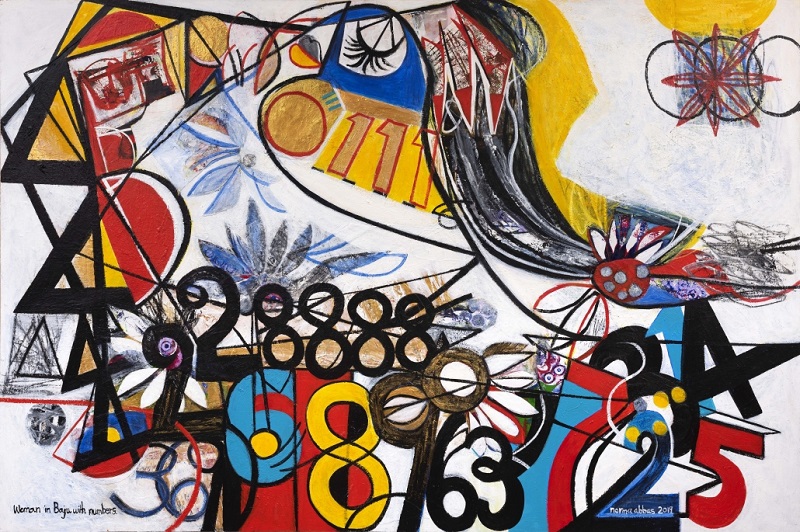
But certainly, being a married mother of two and Malay did not make it easier. She observes, “The art scene was still small in the late 1980s, and the walk-in customers were mostly foreigners. I thought maybe the Malaysian crowd didn’t like my work — maybe as a Malay woman doing figure work — which was controversial at one point.”
But Norma went with the flow. Her artistic practice has seen her shift from monoprint-making to mixed-media collage and, now, painting again. As with the numbers, she painstakingly worked on progressing each style and medium, developing her body of work.
At the end, however, she does not see the need for everything to converge into a neat conclusion or summary, a realisation attributable to her Islamic faith, her life experiences and, maybe, being a woman of her generation.
Where others may write in their diary, Norma Abbas paints her stories on the canvas, be it happy days or sad days. “Some are sweet, some are not. It’s just a sum of these, and they become memories,” she notes, eschewing the desire for a neat little bow on top of it all.
If faith is her anchor, art is simply life to Norma. As with the numbers, the artist wanted the effort of it all to fade. “I wanted to make sure the numbers blended in and would just be part of the work, not stand out. Like my life.
“In fact, the universe is created by numbers; we just don’t pay attention or realise it. Spiritually as well, numbers play a role in all religions. And, so, as life goes on, I wanted the works to reflect that.”
After all, for any diarist, verbalising and keeping a record is as important as knowing that his or her innermost thoughts or “codes” are kept safe within their world.
It is perhaps apt, then, that Norma hopes her contribution to Malaysian arts is exactly that — a contribution. “I never thought about it this way. I hope my art is good enough to be considered a contribution, and will be part of the art cycle in Malaysian art.”
'Coded Diaries' is on at Wei-Ling Gallery, 8 Jalan Scott, Brickfields, KL until Oct 22. See here for more info.
This article first appeared on Oct 17, 2022 in The Edge Malaysia.


